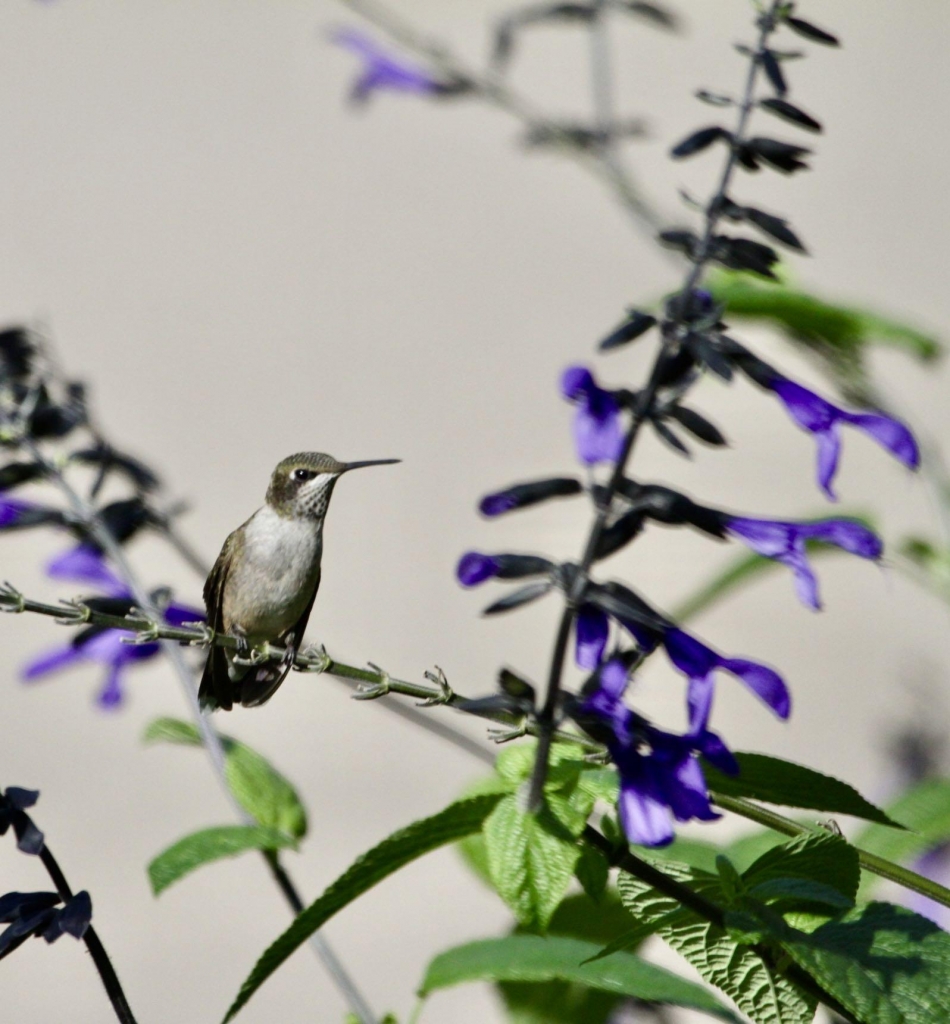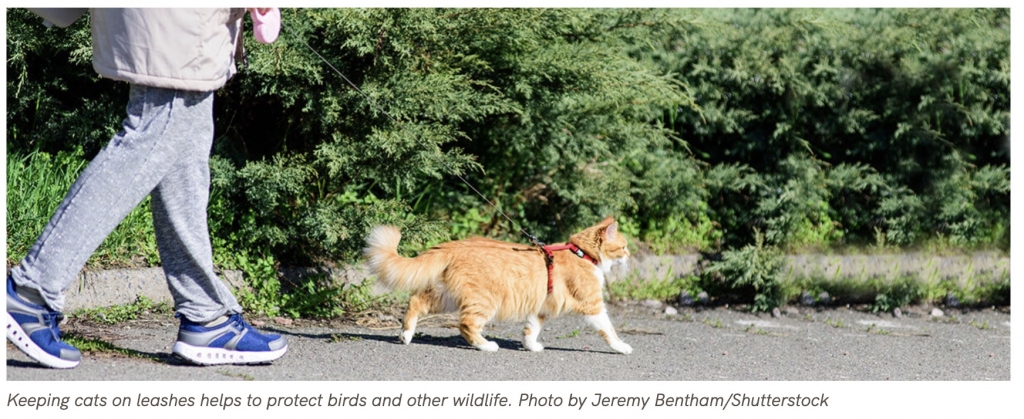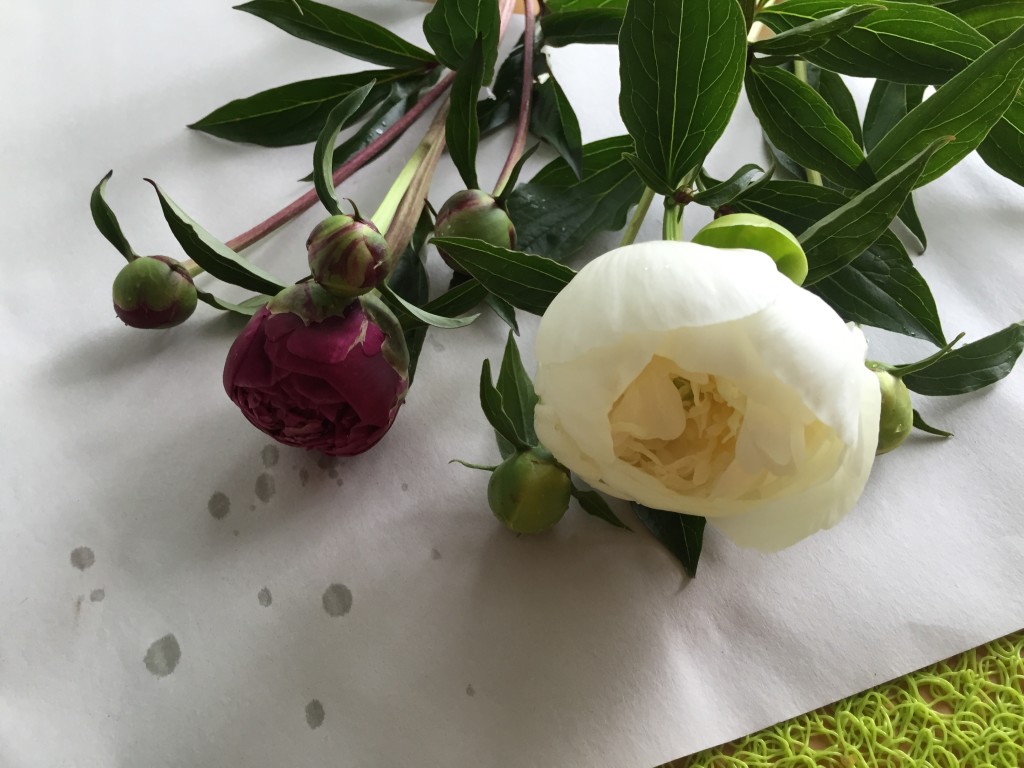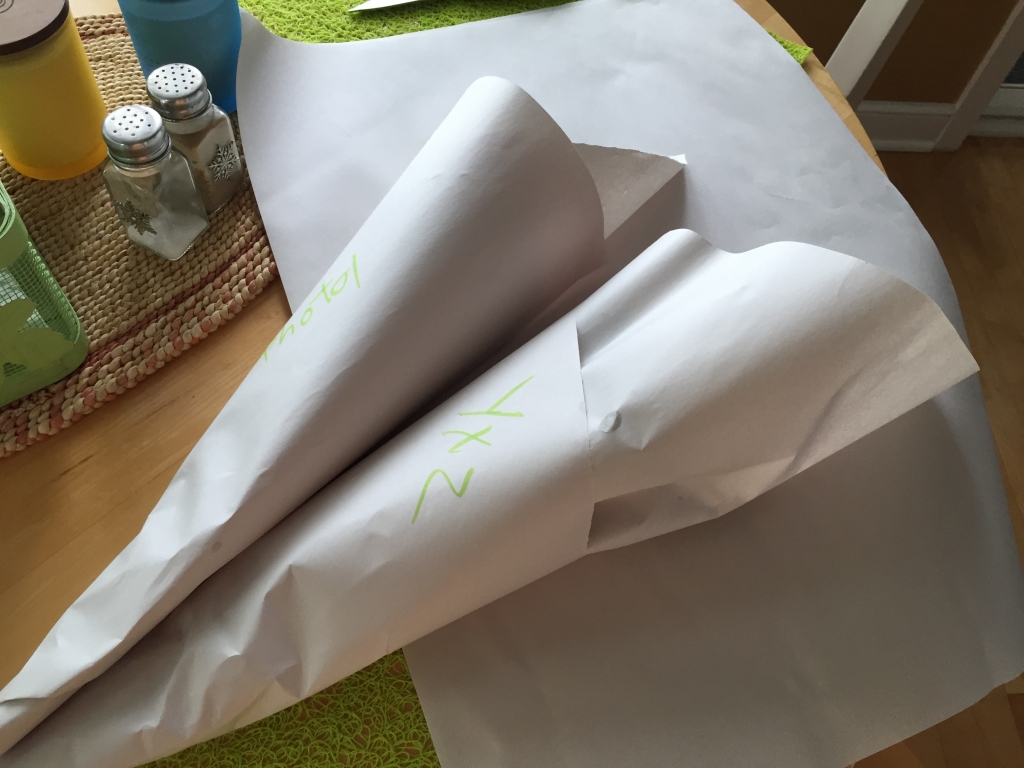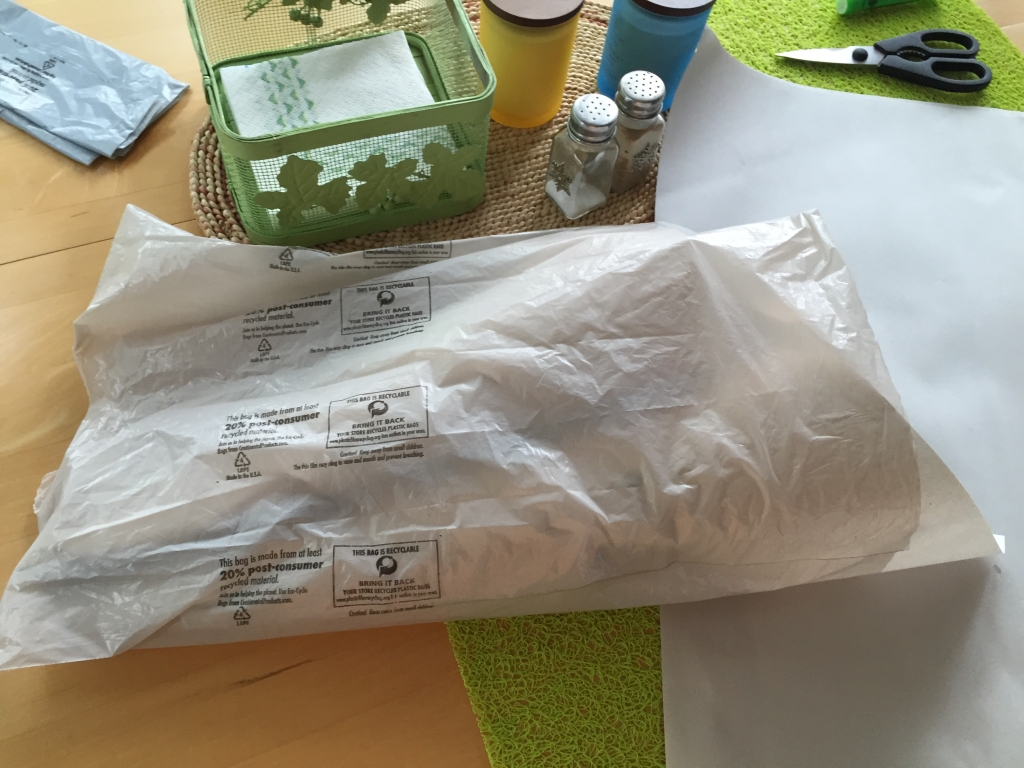April 2024 – Nectar and Nests: Inviting Orioles and Hummingbirds into Your Yard
Hummingbirds and Orioles are some of the most intrepid migrants—they travel thousands of miles each year. To accomplish this remarkable feat, they rely on the abundant supply of nectar usually found within flowers that have co-evolved with nectar eaters over thousands of years. Like other migrants, nectar-drinking birds are also vulnerable to extreme weather, disease, and predators. In addition, climate change and development are causing habitat loss, and the birds are threatened by collisions with windows and cell towers.
These migratory birds arrive hungry!
We can help keep them stay safe and well fed by creating a welcoming environment in our yards.
Providing Carbohydrates
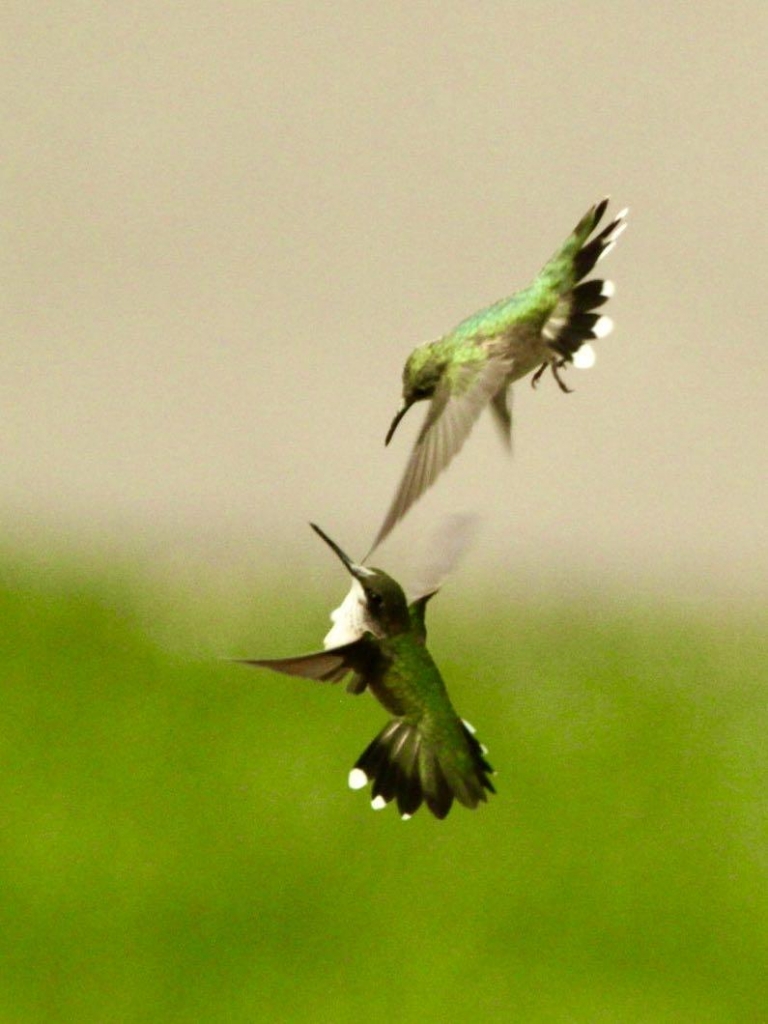 For Hummers: Hummingbirds must eat once every 10 to 15 minutes and visit between 1,000 and 2,000 flowers per day to sustain their supercharged metabolisms. Feeders stocked with sugar water provide needed carbohydrates, attract hummingbirds, and once they find a feeder they like, they visit frequently. Feeders require frequent cleaning and filling to keep the birds coming. If neglected, feeders can pose a health threat to the birds.
For Hummers: Hummingbirds must eat once every 10 to 15 minutes and visit between 1,000 and 2,000 flowers per day to sustain their supercharged metabolisms. Feeders stocked with sugar water provide needed carbohydrates, attract hummingbirds, and once they find a feeder they like, they visit frequently. Feeders require frequent cleaning and filling to keep the birds coming. If neglected, feeders can pose a health threat to the birds.
Orioles will use these feeders as well.
To Prepare a sugar water solution: Mix one part white sugar with four parts water. Bring the mixture to a boil to sterilize it and dissolve all of the sugar. Store any unused mixture in a refrigerator. Clean feeders every two or three days under hot running tap water, scrubbing them with a bottlebrush to eliminate fungus. Do not use honey in feeders, as this can grow mold. Also avoid red food coloring—it is unnecessary. To keep ants out of the feeder I suggest using a feeder with a moat on top. The newer feeders include these. I have made successful moats using a cork and the top of. plastic water bottle….I like the homemade ones because water evaporation is less of an issue.
For Orioles: Lure orioles up close by offering halved oranges on spikes or grape jelly in special feeders or small bowls. These foods also can be attractive to hummingbirds.
Tying red or orange artificial flowers to your feeders can be a visual clue for the birds.
Providing Protein
As their eggs hatch, the birds need protein to feed their young. While pollen from flowers contains the protein they need, the bulk of their protein comes from the insects they eat.
Having mealworms available for the orioles provide the protein needed to help bring healthy fledglings to adulthood. These can be served either fresh (favored by birds) or dry.
For the hummingbirds, their protein will come mainly from small insects, insect eggs, insect larvae and spiders….not that easy for you to provide.
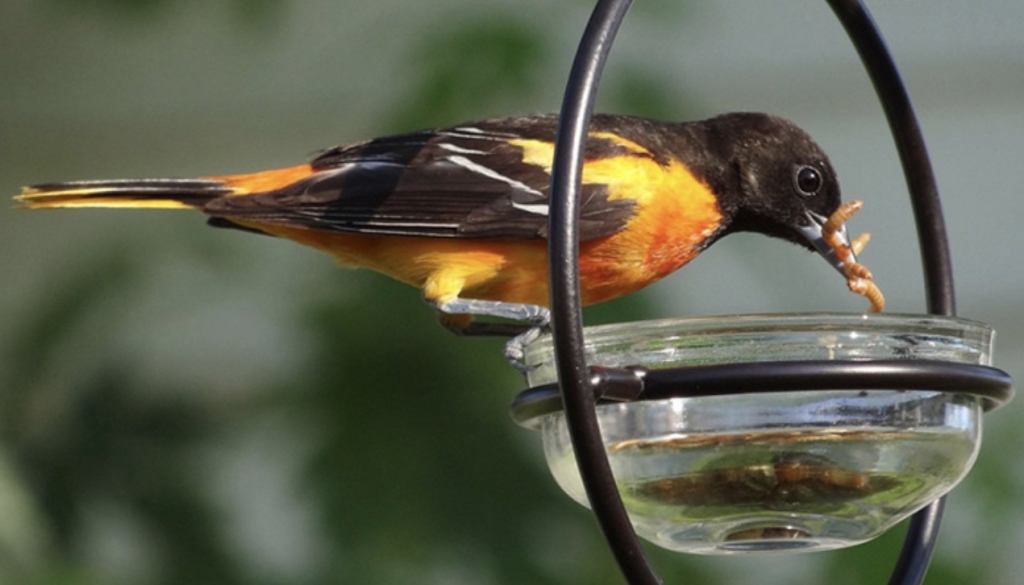
Selecting Plants
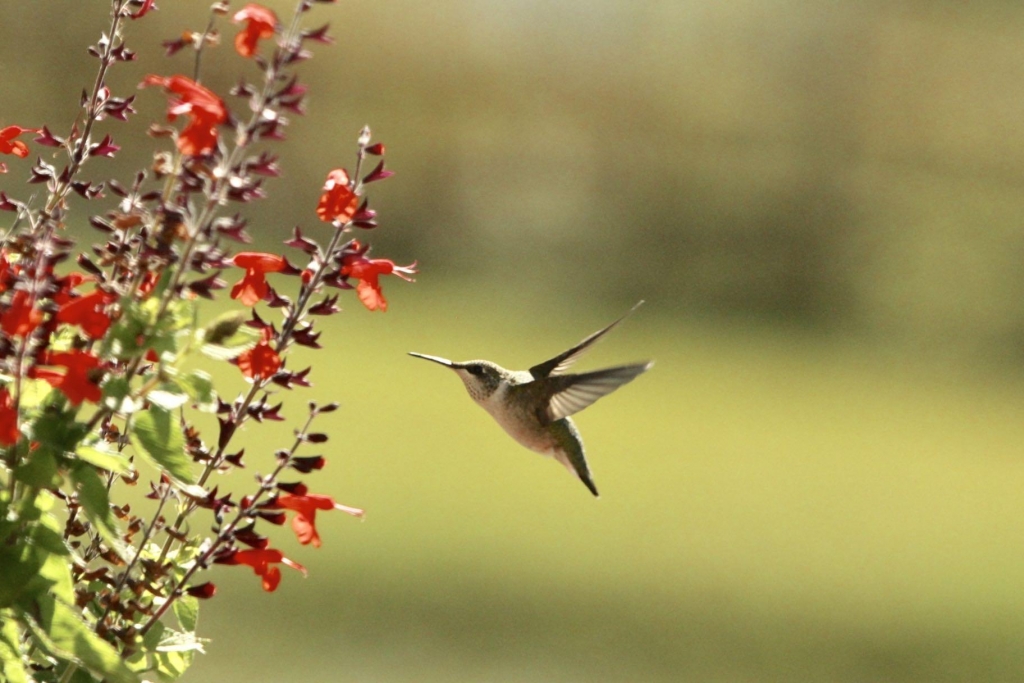
Hummingbirds: Choose plants with red, pink, or orange flowers, with a tubular shape.
Tubular flowers contain nectar at the bottom, which encourages these long-beaked birds to probe for their sweet meal. In general, flowers that rely on fragrance to attract insect pollinators are not good nectar sources, as most birds have a poor sense of smell. However, insects attracted to a plant can serve a source of protein for the hummoingbirds.
Plant patches of three or more individual plants of the same species.
This will provide larger quantities of nectar. Also, prune the tips of flowering plants to encourage bushing and more flowers.
Orioles: Planting fruit-bearing trees and shrubs such as serviceberries, mulberries, and elderberries will provide a natural food supply when the trees mature.
PERENNIAL PLANTS
Selecting perennial plants that bloom at different times provides nectar throughout the growing season. This is especially important in early spring when migrants first return, exhausted from their long travels. Native plants and nectar-eating birds have a long loving association.
This is a short list of plants native to Minnesota that provide nectar for the birds.
Spring
- Pasque Flower (Anemone patens) – (shade to part sun)
- Anemone (Anemone caroliniana) (sun to part shade)
- Candy Tuft (Ibreus) (prefer full sun)
- Shooting Star (Dodecatheon amethystinum) (shade)
- Virginia Bluebells (Mertensia virginica) (Shade to part sun)
Summer
- Bearded tongue (Penstemon spp.): perennial
- Bee balm (Monarda fistulosa, Monarda didyma): perennial with purple, pink, or red flowers
- Cardinal flower (Lobelia cardinalis): perennial; requires moist soil, partial shade
- Columbine (Aquilegia canadensis): perennial with orange-yellow flowers
- Coral bells (Heuchera sanguinea): compact perennial with small red flowers
- Jewelweeds (Impatiens spp.): annual
Fall
- Salivia
- Monarda
- Asclepias (milkweeds)
- Echinacea (coneflower)
- Hypericum (St. Johnswort): compact shrub – while not native, it has naturalized in the Midwest
- Catmint
A more complete listing of native flowers by season can be found at:
https://minnesotawildflowers.info/page/whats-blooming
ANNUAL PLANTS FOR CONTINUOUS BLOOM
Nice thing about annuals is that they remain in bloom for most of the summer and up until the first frost. Garden centers around the twin cities will have all of the newest varieties of flowers that attract orioles and hummingbirds.
A very short list is here:
- Salvia
- Lantana
- Butterfly Bush – Now that we are in a zone 5, you might give them a try.
- Mandevilla vine
- Petunias
- Firecracker plant
- Bidens
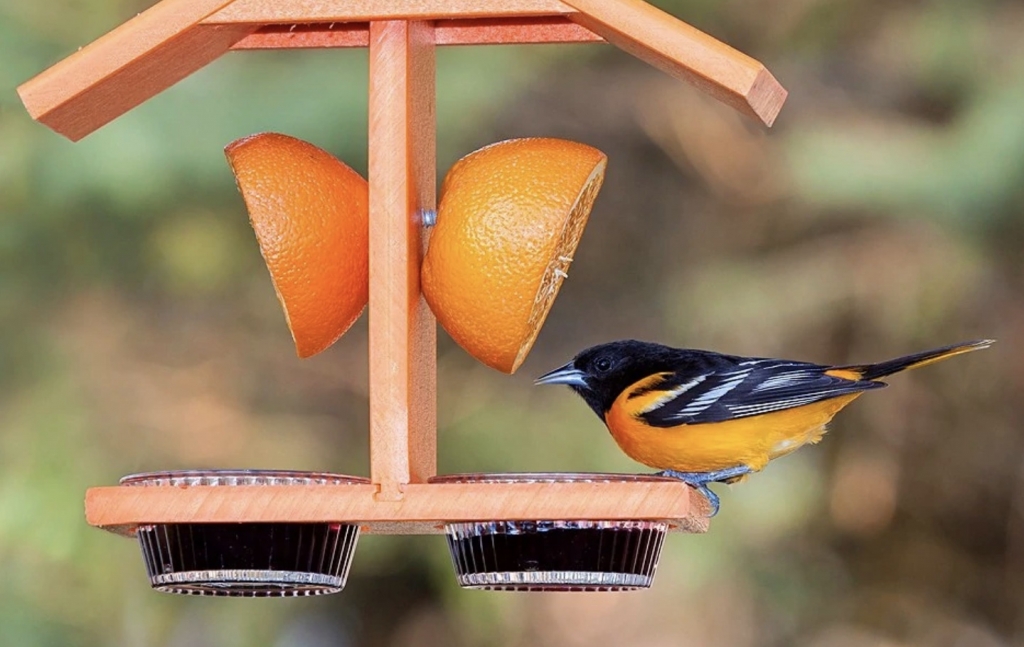
Other Things You Can Do for the Birds
Anticipate the arrival of the Orioles and Hummingbirds.
Have feeders available to the birds by mid-April….or early-May at the latest.
Provide a water feature.
Like most birds, hummingbirds frequently bathe in shallow water, and may preen or flit through the droplets generated by garden misters, drip systems, and small pump-fed waterfalls. Orioles also prefer shallow water— no more than two inches deep. Pebbles or small rocks can make the base less slippery and make the birdbath more inviting.
Provide trees and shrubs.
Hummingbirds and orioles use trees for perching and nesting. Large tree trunks may also provide a source of lichens, which many hummingbirds attach to the outsides of their nests with spider silk for camouflage. Humming- birds usually nest in the forks of small, stiff tree branches; orioles favor the drooping branches of maples, poplars, willows, and conifers. If your garden does not include trees or shrubs, a dead branch with small perching twigs makes a good substitute. Locate these perches near your garden or sugar water feeders.
Think vertically and in layers
Grow a cascade of nectar-rich plants by securing a trellis to your house and planting trumpet honeysuckle (Lonicera sempervirens) beneath it. Trees and garden sheds can also support sturdy trellises for trumpet vine (Campsis radicans). Layer herbaceous or lower-growing plants (see plant selections) in front of vines. Then add window boxes, tubs, or ceramic pots to create a terraced effect and provide growing places for a variety of nectar plants.
Spread out the resources.
Because they are combative, hummingbirds can use some space when possible. If you plant flower patches in several parts of your yard, or separate your feeder locations, this may give less aggressive hummingbirds the space they need.
Birds are fast, but so are cats.
Site any feeders, water features, or flowering plants away from, or well above, where sit-and-wait predators might pounce. Practice and advocate for treating cats like dogs— that is, providing safe and enriching places for pet felines to live indoors full time or supervised and contained outdoorsok…a leash is a hard call for a cat, but actually possible….
Provide snags for clear sight lines…especially for hummingbirds.
Hummingbirds are always on the alert — for food resources, for predators, and for the presence of other hummingbirds. Dead branches provide great lookouts. You can place a large dead branch or leave some dead branches in living trees to provide these lookout points. You may be surprised how quickly hummingbirds, flycatchers, and other birds adopt these “stick” perches.
AVOID PESTICIDES
There are times when pesticides are the only answer, but for the most garden pest issues, using an integrated pest management system is best…. only use pesticides as a last resort. Systemic herbicides can make their way into flower nectar. And both Orioles and Hummingbirds eat small insects and feed many of them to their young. Just as you wouldn’t want children or pets to ingest yard chemicals, the same should hold true for neighborhood wildlife. Let the birds be your natural insect control
About where they live….
Unlike some other popular backyard birds, hummingbirds and orioles do not nest in birdhouses. However, using the suggestions on this page will help you entice them to visit and build a happy home in your yard.
Enjoy Spring!
*Photographer for all photos of the hummingbirds is kathy Kessler.
November 2023 – Trends in Garden Design and Horticulture for 2024
Our gardens are all put to bed and the leaves have been raked (or not). Now is a great time to think about what the new trends are in garden design and horticulture. I ama going to explore things I founds in both the US and the UK …seems like the UK has been doing this longer than we have…. they must have their fingers on the pulse 🙂
Here are some trends that I found in my search
Mix indoors and outdoors
We are all used to bringing nature inside but what about putting and interior space outside. With people typically spending a lot of time indoors, gardeners have realized that the lines between indoors and outdoors are blurring. This expands the living space. Treating your entire property as your home can create a strong sense of home and connection with the natural world.
Set up a “garden room” to expand your living space so you can relax in the fresh air. You can screen off areas with tall shrubs or hanging plants to create the sense of enclosure you have indoors. Provide adequate lighting with fairy lights, overhead lights, lanterns, or outdoor lamps. Make yourself comfortable. A lounge chair or hammock will make your space even more welcoming.
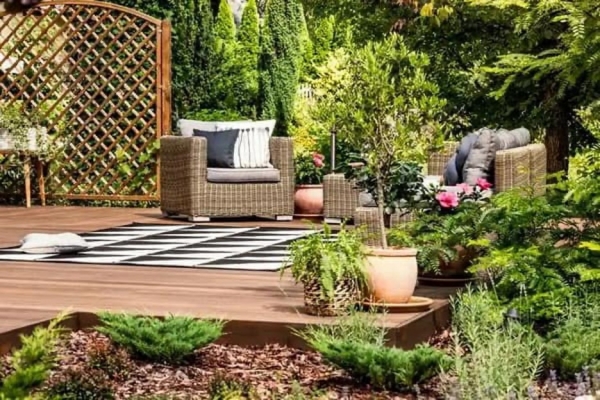
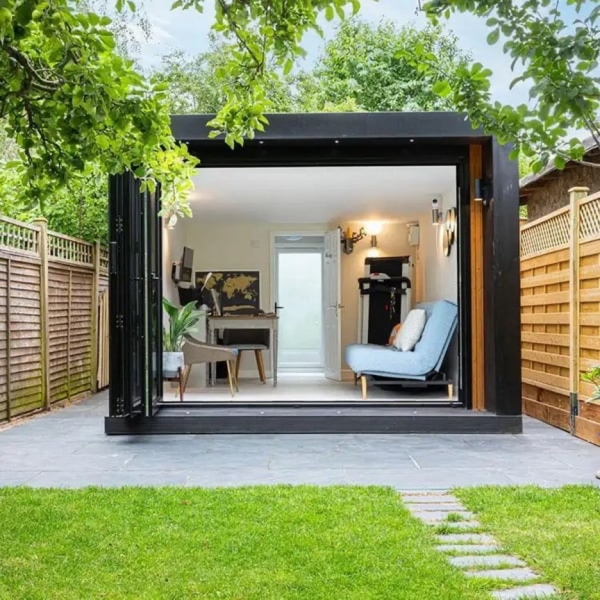
Separate garden room as an office or fitness room
A garden room is always a luxury. And…what if you could have a building separate from the house as your garden room? It could be set up as an office or gym to create some separation between home and work or workout life. It can also be used to create a retreat from the hustle and bustle of the day. It could be ultra contemporary, or the more conventional.
Bright colors in the garden
After the stress and hardships of the pandemic, we all need color in our lives. Planting plans are moving away from the tasteful pastels and muted colors that have been in vogue over the last decade, towards something much more bold. Bright colors are in fashion for spring and summer 2024. The planting is random and natural, like a stylized meadow intended more for pollinators than humans. Mixing brightly colored annuals with your pastel perennials really shows off both.
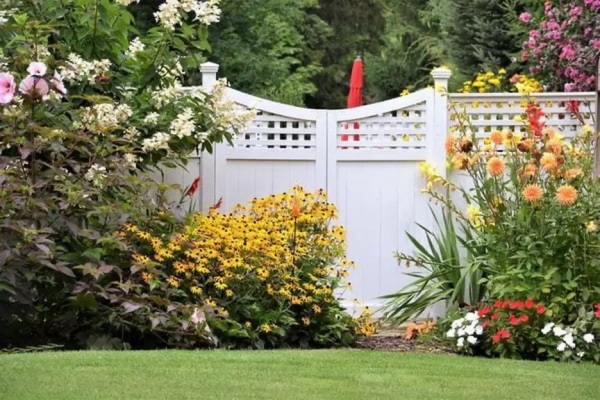
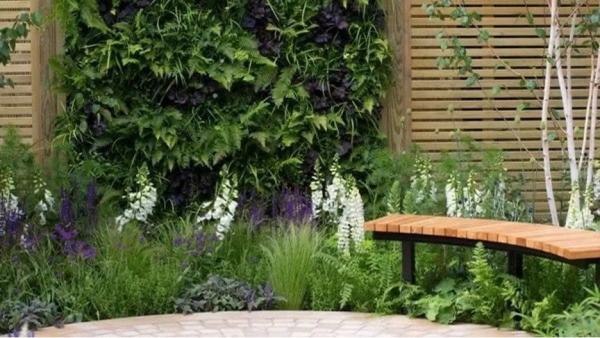
Living Walls
If you’ve always wondered how to create a vertical garden, this is the year to finally give it a try. Overgrown, living walls look much more natural than solid fences. They correspond to the current trends in the garden, where all the available space is used for plants, including the vertical space in your garden. In addition, the plant walls serve as a perfect privacy screen, so you can defend your privacy. And if you already have a garden wall or fence, this may be the right year to plant rampant roses or clematis to cover it.
Geometric shapes are popular
One of the biggest trends I observed online is the use of geometric shapes in paving, outdoor furniture and design. This is due to more natural shapes and materials being used in both the interior and exterior design. This trend is also being carried over to standard products such as planters. New patio blocks come in all shapes and all price ranges.
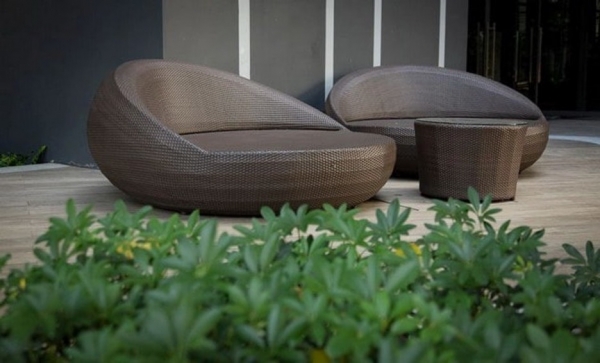

Multiple levels as one of the garden design trends
A garden that extends over more than one level can offer much more than a single level. Different levels help to zone areas. They provide a wonderful opportunity to play with materials. Dividing up the levels is also a good idea when it comes to planting….tall things to the back and shorter things in the front give you a cascading effect. You do not need to depend on your landscape’s grading, with built-in beds at different heights, planting can be designed to fill any line of sight.
October 2023 – Get Ready for a Flavorful Spring: Planting Garlic this Fall
 October is the month for enjoying the foliage, choosing the perfect pumpkin, and planting bulbs – including a kitchen staple garlic. Garlic is simple to grow, and October is the time to get started.
October is the month for enjoying the foliage, choosing the perfect pumpkin, and planting bulbs – including a kitchen staple garlic. Garlic is simple to grow, and October is the time to get started.
There are three common mistakes when trying to grow garlic in Minnesota:
- The wrong seed
- The wrong time
- The wrong place
Let’s focus on the positive as we look at ways to avoid these common mistakes.
The Right Seed:
- Think of garlic as a perennial….A perennial you plant each fall – You want to select the hardiest varieties. The University of Minnesota suggests you select a hard-neck variety. Two varieties recommended by most growers are Porcelain and Purple Stipe.
- Buy Local – Garlic purchased from MN growers will be the hardiest for Minnesota. You can find the local growers at this site:
Upper Midwest Garlic Directory: http://saf-mn.org/garlic-directory/
Garlic bulbs sold by local growers are generally healthy and disease free. One of the diseases that can effect garlic is Aster Yellows….arggg…..I know….. - Size Matters – A larger bulb will have larger cloves. The bigger the clove, the bigger the store of energy.
The Right Time
- Now is the right time. You plant garlic in the fall and in Minnesota from now till the ground freezes is perfect.
The Right Place
- Garlic needs at least 6 hours of direct sunlight per day.
- It likes a rich soil. Prepare your soil by adding organic matter.…the more the better.
- To plant, separate the cloves from the bulb, then set them pointed side up, flat side down about 3 inches deep and 8 inches apart.
- Add a mulch over the planted seeds to help retain moisture and help with weed control.
Leaves emerge and greet you in early spring, followed by scapes (flower stalks) in June – you can eat the stalks, too! Garlic is ready to harvest in early-mid-July. This is a great garden idea for the foodie/cook. Grow and enjoy your own garlic! How awesome!
Here are more links for more information about growing garlic in Minnesota.
- University of Minnesota garlic growing information:
https://extension.umn.edu/vegetables/growing-garlic#choosing-garlic-varieties-867460 - Information regarding the top varieties of garlic for Minnesota
https://sfa-mn.org/resources/seed-garlic-selection-assistance-chart/ - Where to find garlic sellers in Minnesota and Wisconsin:
https://sfa-mn.org/garlic-directory/
September 2023 – Garden Curiosity Unleashed: Discover with These Apps
This month I would like to offer up three free (and ad-free) apps and one subscription for you to investigate.
- iPhone – Your phone uses Siri to offer up suggestions and images to help identify plants and insects.
- PlantNet – Can identify plants using leaves, flowers, or fruit
- iNaturalist – My Go To – Along with identifying plants, this app makes it easy to share and confirm your findings with other observers, including both amateur and professional naturalists.
The one paid subscription I suggest is
- PictureThis @ $29/year
August 2023 – From Harvest to Hues
August in Minnesota is in full swing. It is a month of light winds and cooler nights.
Watch for these August treats:
- Monarchs flocking to lush flowers of pollinator plants, ready to produce the Minnesota offspring that will make their way to Mexico.
- Waves of sunflowers and wild cucumber vines cresting over the tops of trees flourish along roadsides.
- Partake in the garden’s bounty: tomatoes, broccoli, cabbage, cauliflower, sweet corn, beets, carrots, green peppers and zucchini. Gardeners are harvesting and if you are not one of those gardeners, you can find all the fresh produce at the Farmer’s Market.
- Arboretum spectacular: the bloom of the prairie along three-mile drive, apples beginning to ripen, glass pumpkins, and the display of annuals peaking.
It is perfect to take time to smell the roses and absorb all that Nature has to offer us.
July 2023 – The Enchanting Dance of Self-Seeding Plants
Self-seeding annuals and perennials, nature’s ingenious gift to the garden, bring forth a delightful tapestry of colors and textures year after year. These self-sustaining plants possess a unique ability to disperse their seeds and propagate themselves, ensuring a bountiful display without the need for constant human intervention. As their blossoms fade and transform into seed pods, the next generation quietly takes root, perpetuating the cycle of life and beauty. This natural process not only saves time and effort for gardeners but also brings a sense of wonder and harmony to the landscape. By attracting pollinators and supporting biodiversity, these self-reliant botanical wonders become ambassadors for ecological balance.
Self-Seeding Perennials:
- Purple Coneflower (Echinacea purpurea): This native perennial produces beautiful purple flowers and attracts pollinators. It self-seeds readily in full sun to partial shade and well-drained soil.
- Bee Balm (Monarda didyma): Bee Balm features vibrant red, pink, or purple flowers that attract butterflies and hummingbirds. It thrives in full sun to partial shade and moist soil.
- Black-Eyed Susan (Rudbeckia hirta): With its classic yellow flowers and dark centers, this perennial prefers full sun and tolerates a variety of soil conditions.
- Brown-Eyed Susan (Rudbeckia triloba): While flowers are smaller than the black-eyed Susan each stem is profuse with yellow flowers. Prefers full sun and moderate moisture and is drought tolerant.
- Columbine (Aquilegia spp.): Columbines offer a range of flower colors and attract hummingbirds. They grow well in light shade to partial sun and prefer well-drained soil.
- Blanket Flower (Gaillardia spp.): Blanket Flower displays vibrant red and yellow flowers and is tolerant of drought and poor soil conditions. It prefers full sun.
- Siberian Bugloss (Brunnera macrophylla): An adorable bright blue beauty that finds its way into little empty spaces. Prefers moist shady areas. Grows 12-18” tall.
- Feverfew (Tanacetum parthenium): This plant in the chrysanthemum family been used medicinally for many years. It is commonly known as Feverfew, and it is a tall plant, 36 inches in height, with deeply-cut green leaves and white daisy-like flowers with yellow centers.
- Balloon flowers (Platycodon grandiflorus): Available in white, pink and blue these flowers prefer full sun to part shade, moderate moisture and rich well-.drained soil.
Self-Seeding Annuals:
- Cosmos (Cosmos bipinnatus): Cosmos produce an abundance of colorful flowers in shades of pink, white, and red. They self-seed easily in full sun and well-drained soil.
- California Poppy (Eschscholzia californica): California Poppies have bright orange or yellow flowers that add a cheerful touch to the garden. They thrive in full sun and well-drained soil.
- Cornflower (Centaurea cyanus): Cornflowers produce striking blue flowers and can also be found in other colors like pink and white. They prefer full sun and well-drained soil.
- Sweet Alyssum (Lobularia maritima): Sweet Alyssum features small, fragrant flowers in shades of white, pink, or purple. It self-seeds easily in full sun to partial shade and well-drained soil.
General tips for success with self-seeding plants:
- Allow the plants to flower and go to seed.
- Sow seeds in a prepared soil (weeds removed and added soil improvements) or let them self-select a location.
- Be patient, as self-seeding plants often take time to establish and spread.
- Avoid use of herbicides and preemergents (Preen) as they hinder the natural self-seeding process.
- Regularly monitor the seedlings and thin them if needed, allowing enough space for healthy growth.
- Water the plants regularly, especially during dry periods, this promotes germination and growth.
- Mulch the area around the plants to protect the soil and retain moisture.
Two things to remember:
Be patient, as self-seeding plants often take time to establish and spread.
Self-seeding plants can be prolific and spread beyond their desired area. If you want to control their spread, remove excess seedlings or consider confining them to specific beds or areas of your garden.
June 2023 – Sowing Magic: Unleashing the Power of Growing Herbs
As June arrives in Minnesota, we experience warmer temperatures and longer daylight hours, making it the ideal time for planting herbs. And what is better than growing your own fresh herbs to use in your cooking. You can create an herb garden with both annuals and perennials. Some herbs appropriate for our Minnesota climate are: chives, thyme, parsley, oregano, sage, and mint.
Perennial Herbs:
- Chives (Allium schoenoprasum): Hardy and resilient, chives are a great addition to gardens in Minnesota.
- Thyme (Thymus spp.): There are many thyme varieties to choose from, including common thyme and creeping thyme, which are well-suited to Minnesota’s climate.
- Sage (Salvia officinalis): Sage is a hardy perennial herb that can withstand Minnesota’s cold winters.
- Oregano (Origanum spp.): Greek oregano and common oregano are both suitable for growing in Minnesota.
- Mint (Mentha spp.): While mint can be invasive, growing it in containers can help control its spread. The container can be buried up to its rim to keep it contained in a garden. Peppermint and spearmint are popular varieties.
- Lavendar (Lavendula augustifolia): Two varieties ‘Munstead’ and ‘Hidcote’ are the two hardiest cultivars. Both are usually rated as USDA Zone 5 hardy, which means they will need a protected spot in most of our Minnesota gardens
Annual Herbs:
- Basil (Ocimum basilicum): Basil thrives in warm weather, so it’s best to grow it as an annual in Minnesota. There are various types of basil available, including sweet basil and Thai basil.
- Cilantro (Coriandrum sativum): Cilantro prefers cooler temperatures, making it an excellent choice for Minnesota’s spring and fall seasons.
- Dill (Anethum graveolens): Dill is an annual herb that grows well in Minnesota and is commonly used in pickling and cooking.
- Parsley (Petroselinum crispum): Both curly parsley and flat-leaf (Italian) parsley are suitable for growing in Minnesota.
- Annual varieties of thyme and savory: Although thyme and savory are typically perennial, there are some annual varieties available that can be grown as one-season herbs in Minnesota.
Hints for a Healthy Herb Garden
- Choose the right location: Find a sunny spot in your garden with well-drained soil. Most herbs prefer at least six hours of direct sunlight per day, so select a location that receives adequate sunlight. Ensure that the soil drains well, as herbs generally do not like soggy conditions.
- Prepare the soil: Before planting, prepare the soil by loosening it and adding organic matter like compost. This helps improve drainage and provides nutrients to the plants.
- Planting and spacing: Follow the planting instructions for each herb, as spacing requirements may vary. Generally, space plants according to their mature size to ensure they have adequate room for growth and air circulation.
- Mulch: Apply a layer of organic mulch, such as straw or wood chips, around the base of the plants. Mulch helps retain soil moisture, suppresses weeds, and moderates soil temperature.
- Watering: Proper watering is crucial for establishing healthy plants. Water deeply and less frequently, allowing the soil to dry out slightly between waterings. Avoid overwatering, as this can lead to root rot and other issues.
- Fertilization: Herbs generally do not require heavy fertilization. However, a light application of balanced organic fertilizer in spring can help promote growth. Follow the product instructions for application rates.
Recipes for Great Summer Beverages
Mint Lemonade:
Ingredients:
- 4 cups water
- 1 cup freshly squeezed lemon juice
- 1/2 cup granulated sugar
- 1/4 cup fresh mint leaves, torn
- Ice cubes
Instructions:
- In a saucepan, combine water and sugar. Heat over medium heat until the sugar dissolves completely.
- Remove from heat and add the torn mint leaves. Let the mixture steep for about 10 minutes.
- Strain the mint-infused syrup into a pitcher.
- Add lemon juice to the pitcher and stir well.
- Fill glasses with ice cubes and pour the mint lemonade over the ice. Garnish with fresh mint leaves, if desired. Serve chilled.
Note: You can create variations of this recipe by adding lemon verbena in place of the lemon juice. You can also reduce the sugar…or eliminate it completely…for a less sweet drink.
Rosemary and Grapefruit Mocktail:
Ingredients:
- 1 cup grapefruit juice
- 1/2 cup sparkling water
- 1 tablespoon fresh rosemary leaves
- 1 tablespoon honey
- Ice cubes
- Grapefruit slices for garnish
Instructions:
- In a glass, muddle the fresh rosemary leaves with honey until well combined.
- Add grapefruit juice to the glass and stir until the honey is fully dissolved.
- Fill the glass with ice cubes and top it off with sparkling water.
- Garnish with grapefruit slices and a sprig of fresh rosemary. Serve chilled.
Basil Strawberry Lemonade:
Ingredients:
- 4 cups water
- 1 cup freshly squeezed lemon juice
- 1/2 cup granulated sugar
- 1 cup fresh strawberries, hulled and sliced
- 1/4 cup fresh basil leaves, torn
- Ice cubes
Instructions:
- In a saucepan, combine water and sugar. Heat over medium heat until the sugar dissolves completely.
- Remove from heat and add the torn basil leaves. Let the mixture steep for about 10 minutes.
- Strain the basil-infused syrup into a pitcher.
- Add lemon juice and sliced strawberries to the pitcher and stir well.
- Fill glasses with ice cubes and pour the basil strawberry lemonade over the ice. Garnish with fresh basil leaves or strawberry slices, if desired. Serve chilled.
Enjoy experimenting with these herbal beverages!
April 2023 – Spring into Summer – Saving Peonies
Peonies….what great cut flowers. Their blooms are so large they make a big impact with only a few blossoms. What if you could make the season last longer? Would you do it? Well, here is an idea that prolongs peonies for later….much later…. bouquets.
Commercial cut flower operations pick their peony buds and can successfully store them for up to three months. This practice allows them to extend the marketing season as the actual peony bloom season is pretty short. Our home refrigerators are not as cold as those used by the commercial growers, making our saving time a bit shorter….. My daughter was getting married in mid-July….and I wondered….”Can I save them for 6-8 weeks in the refrig?” I just had to try. AND it worked….it really worked.
Before you begin you need
- While you could use newspaper, the ink can rub off. I suggest a tablet of newsprint purchased from a craft store.
- Plastic bags. I found the bags from the Sunday newspaper were great. They are long and narrow.
- An empty crisper drawer in your refrigerator. This might be the hardest thing of all! If you have a second refrigerator that could help matters.
The preparation/storage process
- In late May, cut the peonies when they are like large, soft marshmallows…. Not knowing just how well they would save I cut them at various stages of open….hoping to have a few that worked well. Single pettaled varieties should be cut when the buds are tighter than the multi pettaled double flowers.
- Because ants may already be crawling on the buds, I suggest you rinse buds off and pat dry with paper towels. The last thing you want is ants marching inside the refrig.
- Remove almost all of the leaves as they tend to produce too much moisture when bagged resulting in the buds rotting.
- Wrap buds in newsprint. The newsprint keeps the buds from touching the plastic….this is to avoid moisture build up and mold development. I labeled the outside of each package with the number of stems .and color of the blooms
- Cut a small hole in the bottom of a plastic bag that is large enough for you to insert your hand
- Lacing you hand through the hole, place wrapped buds inside the a plastic bag. (You could use two-gallon zip-lock bags, but I find the newspaper plastics a bit longer so I can keep the stems longer.) Close the bag tightly to keep plants from drying out.
- The packaged peony buds are stored dry, and placed flat on the shelves of the refrigerator. You will be surprised how many will fit into one drawer.
To use the flowers
You need to plan ahead….Once removed from the refrigerator it will take from 8 to 24 hours for buds to open. When the buds are first removed from the refrig, the blossoms may look wilted. DO NOT PANIC. The ends of each stem may look dry. Re-cut the stems to expose clean fresh tissue and place upright in a bucket or vase containing room-temperature water. Cold water slows the opening process.
Other things you may want to know
- For best results storing flowers for no more than 3-4 weeks is best. Once the stored flowers are arranged, they should last 5-10 days. I saved mine in the refrigerator for 8 weeks. While they looked good for our daughter’s wedding, they lasted only 2 days. We used the bouquets for both the rehearsal dinner and the wedding reception.
- If you cut your buds when they are too tight, they will not open…if you cut them when they are too open the petals will fall quickly. This is a trial and error process. Your success will improve with experience. I suggest you keep a journal (and maybe even take pictures). This will help you track what worked and what did not work.
(vlog about peonies from UMN Morris: https://youtu.be/R9C48CGhkP4)
November 2022 – When Is a Lily Not a Lily?
There are eight beautiful, cold-hardy types of perennial lilies for your summer garden: Asiatic, Oriental, Trumpet, Orienpet (cross between Oriental and Trumpet), LA hybrid (cross between Asiatic and Longifolium/”Easter lily”), Turk’s Cap, Martagon (shade), and Canada Lily (native) All of these lilies are in the genus lilium (family Liliaceae). They are grown from BULBS.
While all true lilies are grown from bulbs, not all lily-like flowers grown from bulbs are true lilies.
So…when is a “lily” not actually a lily? Here are some examples:
- Calla Lily – Zantedeschia/Araceae family – tender bulb
- Rain Lily – Zephyranthes/Amaryllis family – tender bulb
- Voodoo lily – Amorphophallus – tender bulb
- Day lily – Hemerocallis – perennial tuber
- Canna Lily – – Cannaceae – tender rhizome
- Surprise Lily – Lycoris/Amaryllis family- perennial bulb
- Water lily – Nymphaea/Nymphaeaceae – tender bulb
- Clive Lily – Clivia/Amaryllis family – tender rhizome
- Blackberry Lily – Belamcanda/Iris family – perennial rhizome
- Peace lily – Spathiphyllum – tender rhizome
- Lily of the Valley – Convallaria – perennial rhizome
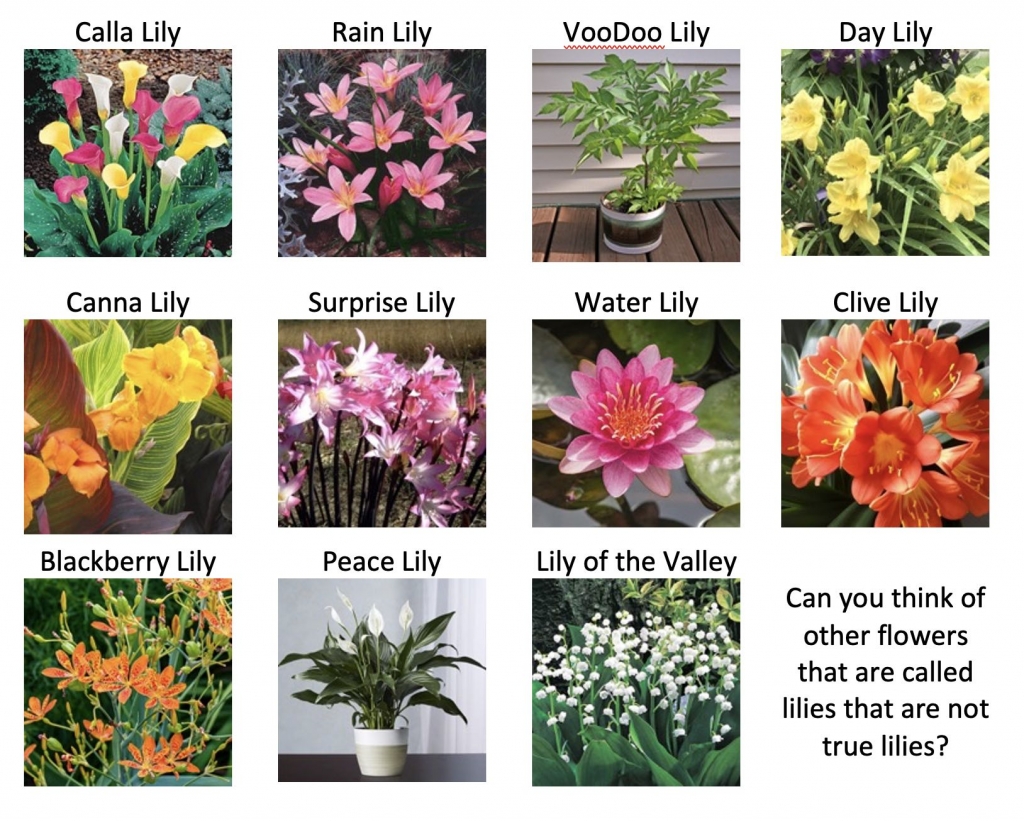
True lilies native to MN: Dwarf Trout lily (Lily family – Erythronium), Wood lily (Lilium philadelphicum), Tiger lily (Lilium lancifolium), Michigan lily (Lilium michiganense, likes wet feet)
For a more comprehensive list of plants called lily that are not true lilies: https://en.wikipedia.org/wiki/List_of_plants_known_as_lily
What is the difference between tubers, bulbs, corms and rhizome?
Even those of us that have been gardening since we were wee ones, often use the words tuber, bulb corm and rhizomes in conversaiton as if they all meant the same thing. While they all seem quite similar, there are definite differences.
- Bulb – has layers of modified leaves growing underground (layers like you see in an onion) – tulips, daffodils, allium, hyacinth, amaryllis, garlic, and of course lilies.
- Corm – similar in look to a bulb, but solid inside -crocus, gladiola, some iris – When it is cut open there are no layers, it is solid flesh.
- Rhizome – grow horizontally, forming roots on the bottom of an underground stem and sends shoots upwards– dahlias, canna lily, lily of the valley, iris (some iris are also grow from corms)
- Tuber – Two kinds of tuber
- True Tuber (modified stems that grow underground)– potato, tuberous begonia, caladium – can be cut up and plant grows form any eye
- Root tuber (swollen roots) – dahlia, daylilies, peonies, sweet potatoes – has one end that has root and one that grows in a more horizontal fashion.
October 2022 – Greener Garden Practices
It is hard to believe it is already October and time begin preparing your yard and gardens for winter.
Here are a few hints for ways to prepare your yard and garden:
- This is a great time to de-thatch your lawn, spread some new seed, add fertilizer and replace sod where needed.
- Your yard and garden need watering through these last dry weeks. Be sure to keep both hydrated till the first freeze.
- Remove and dispose of annuals. They can carry pests and bacteria into next season if left over the winter.
- Leave the seed heads of your perennials, especially the natives, standing for the birds and for winter interest.
- If you cut your perennials down, leave stems 12-18” tall. This provides nesting spots for wild bees and catches the snow adding a layer of protection for the perennials.
- You needn’t bag all of your leaves. Blow them into the garden to add a layer of mulch that provides nutrients and warmth for the coming winter.
University of Minnesota Extension Resources
Fall Lawn Care – https://extension.umn.edu/yard-and-garden-news/fall-lawn-care
Weed control in Minnesota – Consider your tolerance for weeds in your turf. Perfect lawns are resource gluts. However if you think some weed control is necessary, now is the time for adding control for broad-leaf weeds like: dandelions, creeping charlie, wild violets and black medic. The University of Minnesota Extension offers help with identifying broad-leaf weeds as well as ways to control them – https://apps.extension.umn.edu/garden/diagnose/weed/idlist.html
Year-round Lawn Care Calendar https://extension.umn.edu/planting-and-growing-guides/lawn-care-calendar

